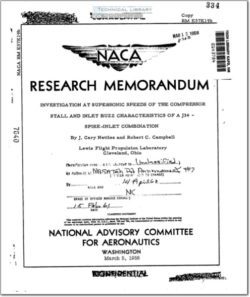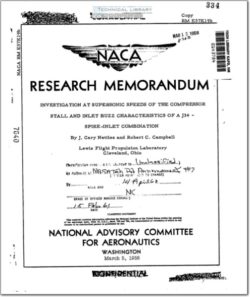NACA-RM-E57K19b

- Version
- 186 Downloads
- 1,014.84 KB File Size
- 1 File Count
- December 4, 2015 Create Date
- December 4, 2015 Last Updated
National Advisory Committee for Aeronautics, Research Memorandum - Investigation at Supersonic Speeds of the Compressor Stall and Inlet Buzz Characteristics of a J34 Spike Inlet Combination

The investigation of the interactions that occur when a supersonic
diffuser is operated with a turbojet engine was extended.by installing
a variable-area exhaust nozzle on a J54 engine to permit the attainment
of limiting engine temperature or compressor pressure ratio at all engine
speeds. For a Mach number range from 1.6 to 2.0 and angles of attack
from O0 to 9° the results indicated that the occurrence of engine stall
was determined by inlet operating conditions because of the flow profile
presented to the compressor. The occurrence of stall was related to a
pressure deficiency at the hub of the compressor and was not predicted
by the distortion parameter. The referred engine airflow tended to in-
crease as the radial distortion level increased.
Approaching the inlet buzz limit with an engine operating in or near
stall did not affect the minimum stable airflow of the diffuser, and con-
versely the presence of mild buzz did not affect the compressor stall
limit.
The stability limits of a double-cone inlet having 15° plus 10° half-
angles were essentially the same with the engine as with a choked plug.
In order to realize the full performance potential of a combination
of supersonic diffuser and turbojet engine, it is necessary that the
characteristics of the two be compatible. Even when the stall and.buzz
margin of each component appears satisfactory by itself, other operating
limits may exist for the combination'because of interaction of one unit
upon the other. Fbr instance, compressor stall and inlet buzz are simi-
lar phenomena, and therefore, when they are coupled together, the dynamic
system response might range from mutual excitation to mutual damping. In
addition, the stall limits of the engine can be influenced by the flow.
profile that the inlet presents to the compressor face.
Investigations of the operating characteristics of an adJustable
supersonic inlet and a J54 engine are reported in references 1 and 2.
These investigations were made with an engine having a fixedrarea nozzle
and operating conditions well removed from compressor stall. lhe scope
of the previous work was extended for the present investigation by utiliz-
ing a different model of the J54 and a variable-area nozzle so that the
engine could be made to stall.
| File | Action |
|---|---|
| naca-rm-e57k19b.pdf | Download |

Comment On This Post